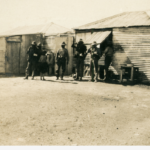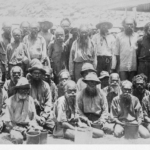The distribution of government rations to Aboriginal people, begun in the earliest days of European settlement, continued well into the twentieth century. In November 1838, to celebrate the arrival of Governor George Gawler, a ceremonial meeting was arranged with the Kaurna people in the Adelaide Parklands. Colonists made speeches, the Kaurna performed songs and dances, and baked beef, and biscuit, rice, sugar and tea were provided. This event set the precedent for an annual distribution of rations in Adelaide, coinciding with the Queen’s Birthday on 24 May, which continued until about 1861.
In 1841, after the violent clash between Aboriginal people and overlanders on the Rufus River, Governor George Grey appointed the explorer Edward Eyre sub-protector of Aborigines and resident magistrate at Moorundie on the River Murray. He was to bring peace to the district, in part by periodically distributing rations of flour and blankets. A similar system was instituted at this time in the Port Lincoln district on Eyre Peninsula. The distributions became more systematic by the late 1840s with new depots being established in frontier districts, usually at police stations, in response to outbreaks of violence. As settlement spread, denying Aboriginal people access to their country and resources, rations were distributed as both a form of compensation and a means of influence. In 1859 there were about 14 depots in operation. The daily food ration was one pound of flour, two ounces of sugar and half an ounce of tea, with other foods, clothing and material items (such as nets and fishing lines) issued on an occasional basis. Issues were restricted to the old, sick or infirm, orphan children and women with children under 12 years of age. The able-bodied were only given rations if they could not obtain work or subsist by fishing and hunting.
One of the few tangible outcomes of an 1860 Select Committee into Aborigines was to expand the system of ration distributions so, by 1867, 58 depots were operating throughout the colony. In the southern settled districts most depots, as before, were located at police stations, while in the northern districts the majority were located on pastoral stations. Rations continued to be issued to Aboriginal people well into the twentieth century. The amount and quality of rations issued on missions and in the settled districts improved gradually over that time, but in the remote regions flour, tea and sugar remained the staples. The practice of distributing rations came to an end in the early 1960s when Aboriginal people became eligible to receive the same government benefits as other members of the community.






Comments
6 responses to “Aboriginal Ration Depots”
Was Gawler a ration station. If not why and which would be the closest
Hi Sue, it looks like we missed the notification for your comment, sorry, but I’d suggest trying ‘Rations Stations’ in Atlas of South Australia, eds. Trevor Griffin and Murray McCaskill for this information.
Proof that the Communists attempting to reconstruct Australian History to suit their Political manouvering by Genocide is just a False narrative. Good work HTSA for keeping the Truth alive.
I’m not sure I follow Andrew. We share articles from many historians here, and the author of this article Robert Foster has published widely in this area, undertaking extensive research which is recognised broadly.
hi im looking for a rationing depot for daveyhurst
Hi Rosanne,
Do you mean Davyhurst in Western Australia? We’ve been unable to locate any records on a Daveyhurst South Australia, and our focus is SA state history. If it is the WA town you’re after I’d suggest getting in touch with state records there – https://www.wa.gov.au/organisation/state-records-office-of-western-austr…